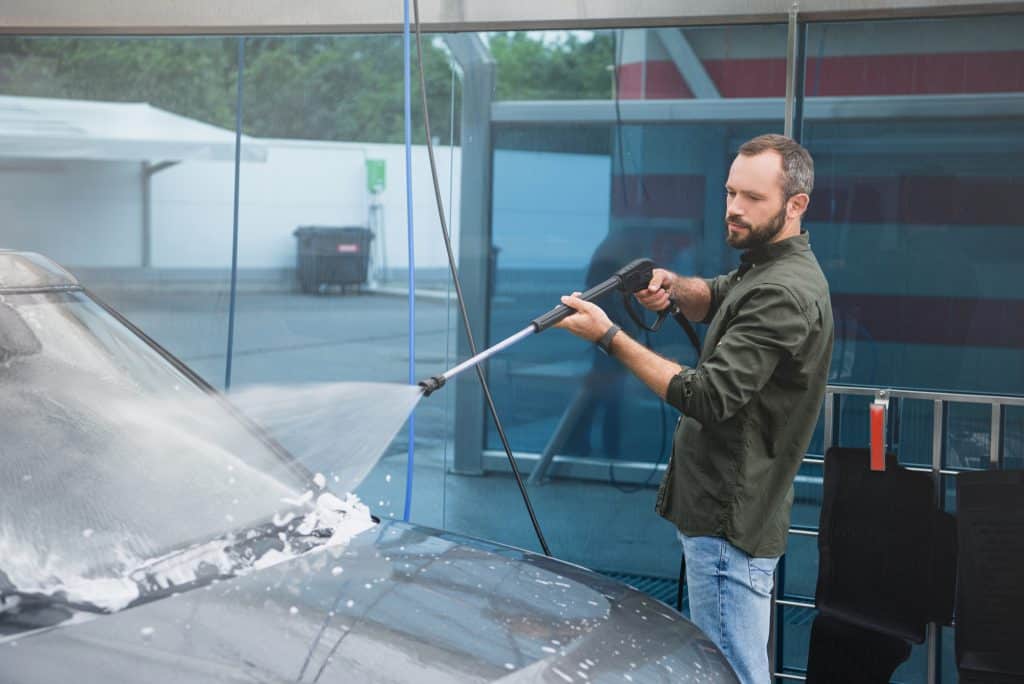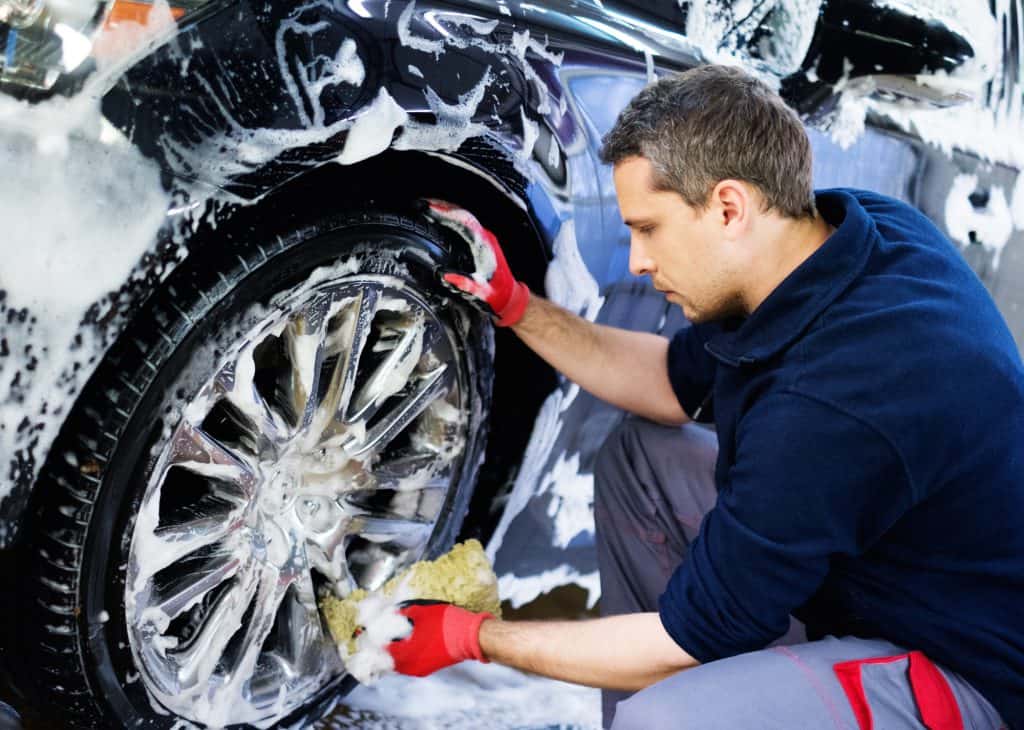In a previous article, we talked about whether or not it was safe for an electric car to go through a carwash. Of course, the answer was yes, it could, and we explained the steps needed for preparation and how to properly take your EV through the carwash. Today we want to return to the topic of washing electric cars, but this time focusing on how to wash them without the help of the automatic carwash.
Washing an Electric Car – Is it Different, in Principle?
In principle, there’s no real or meaningful difference in washing your electric car than washing your regular gasoline car. There are a handful of special things for which you need to be careful, like obviously you’re not going to blast a pressure washer jet down the charging port, nor do you want to douse the car’s battery in water and soap.
Another thing to be sure of is that your ignition is turned off while you are washing the car, and that you are not charging the car at the time. As we just mentioned, you wouldn’t want any water or soap to run into that charging port, would you?
Below we will talk in more detail about the two best methods to wash your electric car, first with a jet wash, and second by using a more traditional hand wash.
Jet Washing an Electric Car

Before you wash
- Ensure that car is not charging and ignition is off
- Ensure that charging port is secured in its enclosure
- Ensure all windows and doors of your EV are closed
- Move the car into a shaded area (not because it’s electric, but because it’s always the best idea)
- Create plenty of space around the vehicle
To make your electric jet washing experience all the more enjoyable, why not consider using an all-electric washer that isn’t powered by a gas engine. It would fit together better with the fact that you own a no-emissions vehicle to ensure that your pressure washer is also a no-emissions piece of equipment.
You should also invest in an eco-friendly and bio-degradable car cleaning agent that can drain away from your car safely without risking any harm to local flora and fauna.
Step 1: Hook Up Your Pressure Washer and Detergent
The first thing is to connect your hose to the pressure washer, plug it in and make sure it can all reach the entirety of your EV wherever you’ve positioned it for washing. Electric pressure washers don’t use batteries, which means it has to be plugged in to an outlet.
Prepare your car cleaning agent in whatever quantity or concentration is instructed and attach that to the nozzle for the next step.
Step 2: Apply the Cleaner All Over the EV
When spraying the car cleaner over your EV, don’t think of it like spraying an electrical appliance. Remember your car’s electrical components are well sealed and protected. Your EV is designed to drive around and even charge in the rain. There’s no danger here. Get an even coating of the cleaning agent all over the surface of your car.
Step 3: Rinse
Next is the time for the pressure washer to shine. Use it to rinse off the car cleaner and remove any dirt clinging to your car’s surface. When using the pressure washer, do be somewhat mindful of turning the pressure up too high and standing too close to your car. This is true of any car, in fact, but with an EV you also need to be mindful about spraying the pressure washer directly at where your main battery is housed. The battery is safely housed, but it’s a good policy not to send powerful jet streams of water at it nonetheless.
Repeat steps 2 and 3 if you feel the car could do with a “rinse and repeat” cycle.
Step 4: Dry
Your car being electric doesn’t make it immune to the effects of water stains. After thoroughly rinsing the car, go around with clean microfiber towels and dry it off. This is where you being in a shaded spot out of the sun will help. Direct sunlight blasting onto your car is just a way to speed up the evaporation of the jet washer water, and thus water marks are created.
Step 5: Wax
The final step in the process is to apply some paint protection and color enhancer. Using a nice carnauba wax will help the color on your EV pop. Synthetic waxes/sealants are also good for providing layers or protection especially against chemical-based contaminants in nature — bird droppings, tree sap and other things.
Work over your car in sections, applying the wax in small, straight lines. You might have heard that circular motions are better, but this is a myth. Your EV was likely more expensive than a regular car. Any risk of swirl marks, no matter how small, is to be avoided at all costs.
Hand Washing an Electric Car

Before You Wash
See the steps for the jet washing and follow a similar procedure for hand washing. You’ll need the following tools as well:
- 2 buckets, one with your car cleaner, and one pure water
- Car hand-washing mitt
- Clean microfiber towels
- Add a dedicated wheel cleaner to your cleaning kit
If you happen to have a pressure washer, it can be a great pre-washing step to first rinse the surface with a pressure washer, especially if its very dirty. The pressure washer will remove the worst of the dirt on the first pass, which makes you job easier when it comes to handwashing. Therefore, if your EV is caked in dirt for whatever reason, a pre-wash rinse works wonders.
Step 1: Start with the Wheels
During a handwash, it’s always better to start with the wheels. Use the alloy wheel cleaner to wash the wheels before you move onto the car body. It seems counterintuitive to start at the bottom, but it works best this way. Wash and dry the wheels carefully, following the instructions of whatever wheel cleaner you have purchased.
Step 2: Wash With the Mitt, Dry with the Towels
Because hand washing your EV will be somewhat slower than the power washer process, you should divide the car into sections and work through one by one. Start with the hood and the rood, then the sides, then the rear, etc. As you wash each one with the wash mitt, make sure you only rinse the mitt in the pure water bucket. In this way, you won’t contaminate your first bucket with your car cleaner. After you’re done washing one section, dry it and move on to the next one.
Take a little care when going over the charging port. Make sure the enclosure is properly closed and secure. Also ensure there are no windows or doors open for the same reason we explained in the power wash.
Step 3: Rinse and/or Repeat (and Dry)
If there were some stubborn parts on the EV that you struggled to get clean, it’s always nice to go over them one more time. Just remember to dry every section of the car that you wash and/or rinse.
Step 4: Wax
A coat of wax as we described in the jet washing steps is a great final step to bring out your car’s color and/or add some simple paint protection. You should remember that natural carnauba wax or synthetic sealant isn’t going to provide physical protection from things like rock chips. What it will do is offer a layer of protection to your clear coat from water-based and chemical-based contaminants.
Conclusion: Mind the Electrics, but Otherwise Wash as Normal
Between the battery housing, charging port and interior electronics, there are things that you should be mindful of when washing an EV. But, with simple steps and the knowledge that these systems are well housed and protected in general, you shouldn’t feel like washing your electric vehicle is really any different from washing your gasoline car.